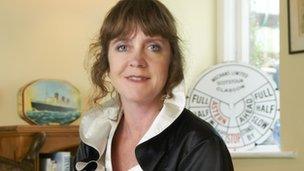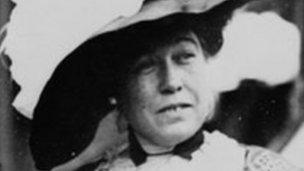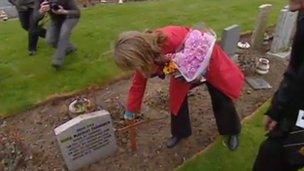Ruined life of Robert Hichens - 'the man who sank Titanic'
- Published

Robert Hichens was one of six quartermasters
When Robert Hichens became a quartermaster on the Titanic he was at the peak of his career.
But for the man steering the doomed liner when it hit an iceberg, the disaster would ruin his dreams and overshadow the rest of his life.
Hichens survived the sinking, arriving in New York aboard Carpathia.
He had been ordered to leave the wheel of the liner less than an hour after the collision and put in charge of lifeboat six.
He rowed more than 40 people to safety but his great granddaughter, Sally Nilsson, believes the disaster blighted the rest of his life and "cartwheeled him to a very tragic end".
His marriage broke up, he became a heavy drinker and twice tried to kill himself, eventually ending up in jail for attempted murder.
"There were two inquiries at the time - one in the US and one in the UK," said Ms Nilsson, from Reigate in Surrey.
"Robert Hichens was one of the most vital witnesses and it is his testimony that forms part of the traditional story that we know today.
"The problem was that his fellow crewmen saw him as jinxed."
It has been suggested that helmsman Hichens misinterpreted the steering orders and steered Titanic the wrong way, into the iceberg.

Sally Nilsson has written her ancestor's biography to "set the record straight"
"I dispute this because he had been at sea since he was 14 and he was 30 when he was on the Titanic," said Ms Nilsson.
"He had worked as a quartermaster for seven years and he would never have made a glaring error like that."
Hichens was played by Paul Brightwell in the 1997 blockbuster film Titanic, where he was shown in a confrontation with one of the passengers, Molly Brown, played by Kathy Bates.
She urges him to turn the lifeboat back to the ship to rescue other survivors, but he refuses.
"Robert Hichens had been given direct orders by his captain to drop off passengers and then return," said Ms Nilsson.
"Molly Brown went to the papers when they were rescued and put the nail in the coffin for Robert, by saying he was a coward and a bully.
"But it was awful, the stuff of nightmares really.

Molly Brown was in lifeboat six, which Robert Hichens commanded
"Robert didn't know which way to go, and there were 16 lifeboats in the same position."
Ms Nilsson, whose grandmother was born just weeks after the disaster and became known as the "Titanic baby", researched her ancestor's life for a biography, The Man Who Sank Titanic.
She discovered the family moved to Torquay in Devon, but did not stay together. Hichens's wife subsequently left to return to Southampton with the children.
Ms Nilsson said Hichens had developed neurasthenia, a nervous condition which would now be termed post-traumatic stress disorder (PTSD).
He set up a boat charter business but later acquired a gun and shot Harry Henley, the man who sold him the boat, during a dispute over money. Mr Henley lived, but Hichens was jailed.
He was freed four years later in 1937, but died in 1940.
"Robert ended up as third mate on a cargo ship in the Second World War, taking coal over to Africa," said Ms Nilsson.

Sally Nilsson planted a wooden cross on the communal grave in Aberdeen
"They delivered the coal and came back but it was his final voyage."
As the ship docked outside Aberdeen, one of the crew members found him dead in his bunk from heart failure.
"For me he died of a broken heart," said Ms Nilsson.
"With all the research I did I discovered a man who was very caring, funny, incredibly loving and totally loyal."
Titanic enthusiast Mandy Le Boutillier said many of Titanic's 705 survivors were affected by what would now be classed as PTSD.
"In those days it was not understood," she said. "They got no back-up at all.
"For a lot of survivors it was such a horrendous experience that it did blight their lives.
"Hichens has been portrayed as a gruff sort, argumentative and quite a sharp character. He has been misrepresented."
In the last few weeks Ms Nilsson tracked down her great-grandfather's grave after a three-year search.
He lies in Trinity Cemetery in Aberdeen and on Thursday she was finally able to go and pay her respects and plant a wooden cross on the communal grave.
"This has been a long journey," she said. "I never met the guy but it means everything. I grew to love him so much."
- Published15 April 2013
- Published12 April 2012
- Published27 March 2012
- Published22 December 2011
- Published22 September 2010
- Published31 May 2011